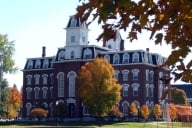You have /5 articles left.
Sign up for a free account or log in.
To produce more physicians for Louisiana, a major academic medical center has joined up with a medical school down under.
The University of Queensland School of Medicine, in Australia, has opened a clinical school in New Orleans in cooperation with Louisiana's Ochsner Health System. Under the arrangement, students will travel to Brisbane for the first two years of medical school, then return to the United States to complete their third- and fourth-year clinical training at Queensland's new outpost at Ochsner. Those enrolled in the collaborative program will graduate with an Australian medical degree, a Bachelor of Medicine/Bachelor of Surgery (MBBS), which is equivalent to an M.D., from Queensland.
This particular program is only open to American students and, while its graduates will be eligible to apply for an internship in Australia, the stated intent is to help address projected physician shortages in the United States, Louisiana especially. “The goal for them is to secure residencies and practice in the United States. Our Ochsner goals are to have our top students stay in Louisiana, and hopefully at Ochsner,” said William W. Pinsky, executive vice president and chief academic officer for the Ochsner Health System. The first 16 students in the program began their training in Australia in January; the goal is to admit 80 students this coming January and the following year, 120 more, “which would be our steady state.”
“This is quite a novel, transnational model of education. We’ve all talked about these sorts of things in the higher education sector for some time but as far as we know, this is the first, certainly the first in Australia, and we’re not aware of any other partnership like this in the United States," said David Wilkinson, dean of medicine and head of the medical school at Queensland
Queensland's medical school, which is positioning itself as "Australia's global medical school," also has a clinical school in Brunei, in Southeast Asia, and is in the early stages of establishing a shared teaching site in Malaysia, Wilkinson said. About half the medical school's students spend a portion of their studies overseas, and they can now come to Ochsner for a clinical rotation. "That's a very important part of this program, that we have mixed student cohorts," said Wilkinson.
Apart from the education component of the collaboration, Pinsky added, "To really make this a home run, we need to extend this further in terms of getting into a collaborative relationship with research."
Australian universities have been active in establishing branch campuses abroad, although, with the exception of Charles Stuart University's campus in Ontario (offering degrees in education and business), not typically in North America. In fact, rather than have their ranks reinforced from abroad, some U.S. medical schools have set up shop elsewhere -- take Cornell University's medical campus in Qatar, for instance, and Duke University's partnership with the National University of Singapore.
And while many university entities have developed joint, dual or otherwise transnational degrees in recent years, it's more complicated terrain in schools of medicine given licensure and accreditation requirements, and extra hurdles that foreign medical school graduates must jump in order to practice medicine in the U.S. -- including Educational Commission for Foreign Medical Graduates certification.
In this case, a graduate of the Queensland/Ochsner program applying for licensure in Louisiana “will be considered an international medical school graduate, and will be required to go through ECFMG and meet the various requirements associated with that. But I imagine that would not be a problem, and that they’ll end up doing post-graduate training here in Louisiana, some of them at Ochsner, some in the growing network of Ochsner facilities,” said Robert Marier, executive director of the Louisiana State Board of Medical Examiners.
Marier, a former medical school dean, said the Ochsner/Queensland partnership strikes him as pretty unique, “in one respect. There are offshore medical schools, international schools, in the Caribbean, for instance, which have established relationships with hospitals in the United States and they send significant numbers of their students, most of whom are also U.S. citizens, up to these hospitals for clinical training. That’s not new.... I think what’s different about this arrangement is Queensland is a great university, it’s not a for-profit off-shore medical school. It’s a great university and aspires to be a world player, and with good reason…. And Ochsner is a major, major teaching hospital, so I think it’ll be excellent clinical training for these students.”
“It’s very important to understand that this is a very serious and genuine attempt at an exciting transnational collaboration. This is not a, if you will, a Caribbean medical school, run by a bunch of businessmen. This is a very serious transnational collaboration between one of the world's leading universities and one of America’s leading integrated health systems,” said Wilkinson, the head of Queensland’s medical school.
Queensland’s School of Medicine is accredited by the Australian Medical Council, and the school has submitted an application regarding the new arrangement with Ochsner for the council's approval; the accreditor's decision is pending. “We are hopeful but we are also conscious that this is a novel partnership,” said Wilkinson.
As for those students who have already started the joint Queensland/Ochsner program, in the event that the accreditor does not approve it, or does not do so in a timely fashion, "students who enroll will be expected to complete their four year medical education at University of Queensland in Brisbane, Australia," as Queensland's Web site for international applicants notes.
John Prescott, chief academic officer for the Association of American Medical Colleges, said that he was struck by the partnership given that Ochsner has had a long history of working with students from the medical schools at Louisiana State and Tulane Universities (Pinsky said the long-standing affiliations with Louisiana-based medical schools are continuing amid the development of its new partnership with Queensland).
“The prime difference is that the LSU students and the Tulane students are from schools accredited by the Liaison Committee on Medical Education," Prescott said. The LCME is sponsored by the AAMC and the American Medical Association, and only accredits medical schools in the U.S. and Canada.
“I re-watched the press announcement where the governor [of Louisiana, Bobby Jindal] and others were talking about helping to meet the needs of Louisiana. If it helps to do that, wonderful, that would be a truly wonderful thing,” Prescott said (the AAMC has been among those calling attention to the projected physician shortage and need to increase medical school capacity). Other than that, Prescott continued, “I know the American system very well. I don’t know the system well for Australia, and would have to wait before I make further comment... I’d have to just see how this would roll out.”








